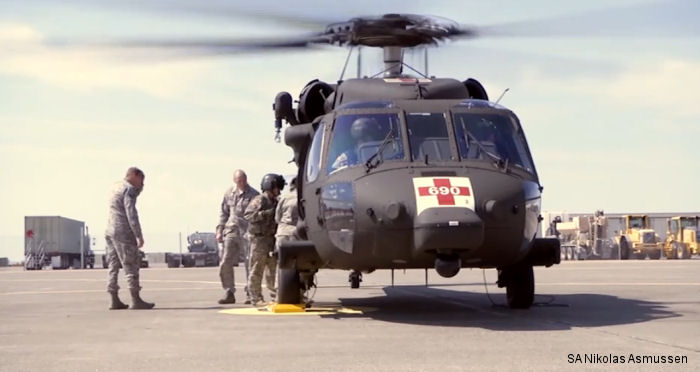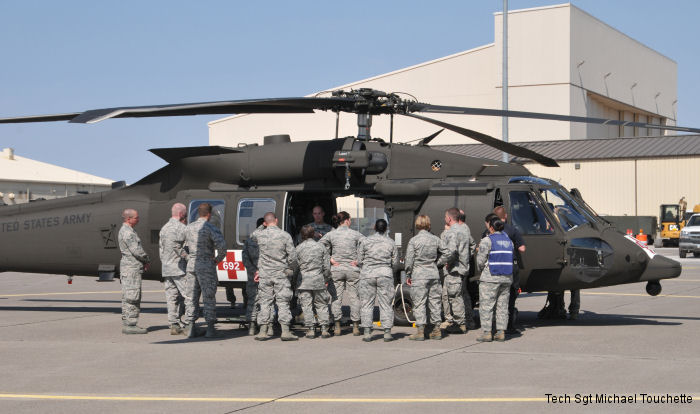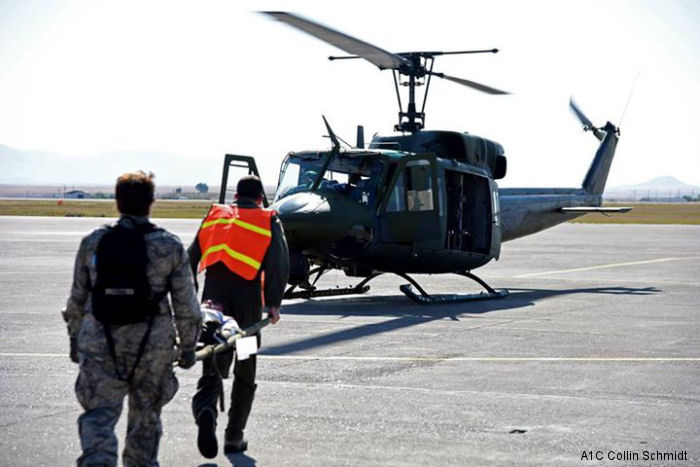US Air Force, August 14, 2015 - GREAT FALLS, Mont. By Tech Sgt Michael Touchette - Montanans are adept at handling what Mother Nature throws our way - cold, snowy winters with negative double-digit temperatures punctuated by several summer months with sweltering triple digit temperatures.
But sometimes Mother Nature throws us a curve.
On Aug. 10, 2015, as part of a joint mass casualty exercise, a simulated earthquake occurred in the Great Falls area. In the exercise scenario the quake caused structural damage throughout the region, including a partial collapse of the Malmstrom Air Force Base auditorium, where the wing commander was holding a commander’s call.
The scenario was not far-fetched; the United States Geological Survey reports there were 112 earthquakes in the state of Montana last year alone, most of which have been in the Helena and Kalispell areas.
The victims of the disaster were played by Airmen who spent hours prior to the exercise getting moulage makeup applied and dressed in torn, dirty and bloody clothing.
“Having these kinds of planning exercises and working together in advance ensures that when those things do happen there’s already protocols in place, there’s already response protocols that work and that have been tested,” said Maj. William C. Thompson, 120th Airlift Wing health services administrator.
Once the exercise kicked off, personnel from the Malmstrom Fire Department and other first responders began rescue operations, sending victims by litter or by foot to the Malmstrom Clinic for medical treatment.
“When the simulated earthquake happened the 341st Medical Group was notified that they had a building collapse on the base and realized they were overwhelmed with casualties, that there were too many people to manage with the resources they had on the base and that’s what initiated the further reach out to Great Falls Emergency Services, to the 120th Medical Group at the Montana National Guard and the aviation regiment out of Helena,” Thompson said.
The Montana Air National Guard’s 120th MDG augmented Malmstrom Air Force base’s 341st MDG with 49 Guardsmen to provide medical care to victims of the natural disaster at the Malmstrom Clinic. Patients arriving at the clinic were assessed and prioritized before being moved to a treatment area.
“It’s very overwhelming for any facility to care for that many patients at one time,” said Capt. Jen Gunter, 120th MDG medical administration officer. “The fact that we could integrate with the team at the 341st Medical Group and work with them to stabilize patients, to treat patients and get them to other facilities for care was very good exercise for everybody involved.”
Several of the patients arriving at the clinic were exposed to hazardous materials during the incident and had to be decontaminated by the medical clinic’s decontamination team prior to entering the clinic. Decontamination was done in a gateway tent, a self-contained structure which allows both ambulatory and non-ambulatory patients to be scrubbed down with warm, soapy water, then rinsed to remove any contaminant on them.
“When you talk about a natural disaster potentially happening in the region you’re going to need more response, more medical support, more transport,” Thompson said. “You know it’s easy to overwhelm the local emergency services, so sometimes you have to go out and reach out to your other emergency services options.”
“Those types of exercises or incidents may occur anywhere in the state of Montana.” Gunter said. “It could be a plane wreck, a train wreck, a tornado like they saw in Billings a few years ago which could end up with multiple patients very quickly.”
In the exercise scenario Benefis Hospital, the local medical center in Great Falls, was unable to take patients from Malmstrom Air Force Base due to a flood of civilian victims from the local community, but they did agree to take one critically injured patient who was transported by ambulance.
“The key toward bringing all of the forces together to not only treat the casualties initially on the ground, but to see that care continues on to another higher echelon where there’s more definitive care, as needed, for more seriously injured patients,” Thompson said.
Malmstrom’s 40th Helicopter Squadron transported several patients to Helena in a UH-1N Huey helicopter. The Montana Army National Guard responded to Malmstrom Air Force base with a CH-47 Chinook helicopter and two UH-60 Black Hawk helicopters.
“Having the aviation regiment out of Helena is an obvious, big support for us,” Thompson said. “And, having the 40th Helicopter Squadron positioned here at Malmstrom and having their helicopters also available to carry litters and casualties to other areas of patient care.”
The helicopter crew chiefs used their time on the ground on Malmstrom’s flight line to instruct Airmen on the proper way to load and unload litters from a medevac helicopter.
“We were learning to load and unload litters off the Army’s helicopters,” said Senior Master Sgt. Nicole Gardner, a health systems technician with the 120th Medical Group.
“We’ve done a couple of other litter loading classes with other National Guard units in Montana, especially at Fort Harrison,” said Army Sgt. Wyatt Shipp, a UH-60 crew chief. “As far as joint operations, this is the biggest one we’ve participated in so far.”
The Army helicopters then loaded patients and flew them to the Helena Regional Airport where they were met by St. Peter’s Hospital emergency services personnel who triaged patients, prioritizing patients for transport to the hospital.
“I believe that’s the big difference between active duty and National Guard,” Shipp said. “We’re able to respond a lot more quickly because we’re based around the state and these are our family and friends that we’ve grown up with, that we know.”
But sometimes Mother Nature throws us a curve.
On Aug. 10, 2015, as part of a joint mass casualty exercise, a simulated earthquake occurred in the Great Falls area. In the exercise scenario the quake caused structural damage throughout the region, including a partial collapse of the Malmstrom Air Force Base auditorium, where the wing commander was holding a commander’s call.
The scenario was not far-fetched; the United States Geological Survey reports there were 112 earthquakes in the state of Montana last year alone, most of which have been in the Helena and Kalispell areas.
The victims of the disaster were played by Airmen who spent hours prior to the exercise getting moulage makeup applied and dressed in torn, dirty and bloody clothing.
“Having these kinds of planning exercises and working together in advance ensures that when those things do happen there’s already protocols in place, there’s already response protocols that work and that have been tested,” said Maj. William C. Thompson, 120th Airlift Wing health services administrator.
Once the exercise kicked off, personnel from the Malmstrom Fire Department and other first responders began rescue operations, sending victims by litter or by foot to the Malmstrom Clinic for medical treatment.
“When the simulated earthquake happened the 341st Medical Group was notified that they had a building collapse on the base and realized they were overwhelmed with casualties, that there were too many people to manage with the resources they had on the base and that’s what initiated the further reach out to Great Falls Emergency Services, to the 120th Medical Group at the Montana National Guard and the aviation regiment out of Helena,” Thompson said.
The Montana Air National Guard’s 120th MDG augmented Malmstrom Air Force base’s 341st MDG with 49 Guardsmen to provide medical care to victims of the natural disaster at the Malmstrom Clinic. Patients arriving at the clinic were assessed and prioritized before being moved to a treatment area.
“It’s very overwhelming for any facility to care for that many patients at one time,” said Capt. Jen Gunter, 120th MDG medical administration officer. “The fact that we could integrate with the team at the 341st Medical Group and work with them to stabilize patients, to treat patients and get them to other facilities for care was very good exercise for everybody involved.”
Several of the patients arriving at the clinic were exposed to hazardous materials during the incident and had to be decontaminated by the medical clinic’s decontamination team prior to entering the clinic. Decontamination was done in a gateway tent, a self-contained structure which allows both ambulatory and non-ambulatory patients to be scrubbed down with warm, soapy water, then rinsed to remove any contaminant on them.
“When you talk about a natural disaster potentially happening in the region you’re going to need more response, more medical support, more transport,” Thompson said. “You know it’s easy to overwhelm the local emergency services, so sometimes you have to go out and reach out to your other emergency services options.”
“Those types of exercises or incidents may occur anywhere in the state of Montana.” Gunter said. “It could be a plane wreck, a train wreck, a tornado like they saw in Billings a few years ago which could end up with multiple patients very quickly.”
In the exercise scenario Benefis Hospital, the local medical center in Great Falls, was unable to take patients from Malmstrom Air Force Base due to a flood of civilian victims from the local community, but they did agree to take one critically injured patient who was transported by ambulance.
“The key toward bringing all of the forces together to not only treat the casualties initially on the ground, but to see that care continues on to another higher echelon where there’s more definitive care, as needed, for more seriously injured patients,” Thompson said.
Malmstrom’s 40th Helicopter Squadron transported several patients to Helena in a UH-1N Huey helicopter. The Montana Army National Guard responded to Malmstrom Air Force base with a CH-47 Chinook helicopter and two UH-60 Black Hawk helicopters.
“Having the aviation regiment out of Helena is an obvious, big support for us,” Thompson said. “And, having the 40th Helicopter Squadron positioned here at Malmstrom and having their helicopters also available to carry litters and casualties to other areas of patient care.”
The helicopter crew chiefs used their time on the ground on Malmstrom’s flight line to instruct Airmen on the proper way to load and unload litters from a medevac helicopter.
“We were learning to load and unload litters off the Army’s helicopters,” said Senior Master Sgt. Nicole Gardner, a health systems technician with the 120th Medical Group.
“We’ve done a couple of other litter loading classes with other National Guard units in Montana, especially at Fort Harrison,” said Army Sgt. Wyatt Shipp, a UH-60 crew chief. “As far as joint operations, this is the biggest one we’ve participated in so far.”
The Army helicopters then loaded patients and flew them to the Helena Regional Airport where they were met by St. Peter’s Hospital emergency services personnel who triaged patients, prioritizing patients for transport to the hospital.
“I believe that’s the big difference between active duty and National Guard,” Shipp said. “We’re able to respond a lot more quickly because we’re based around the state and these are our family and friends that we’ve grown up with, that we know.”
See also |
40th HS
Sikorsky HH-60M Black Hawk







